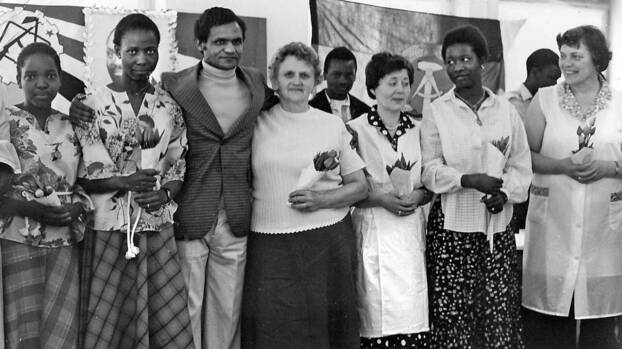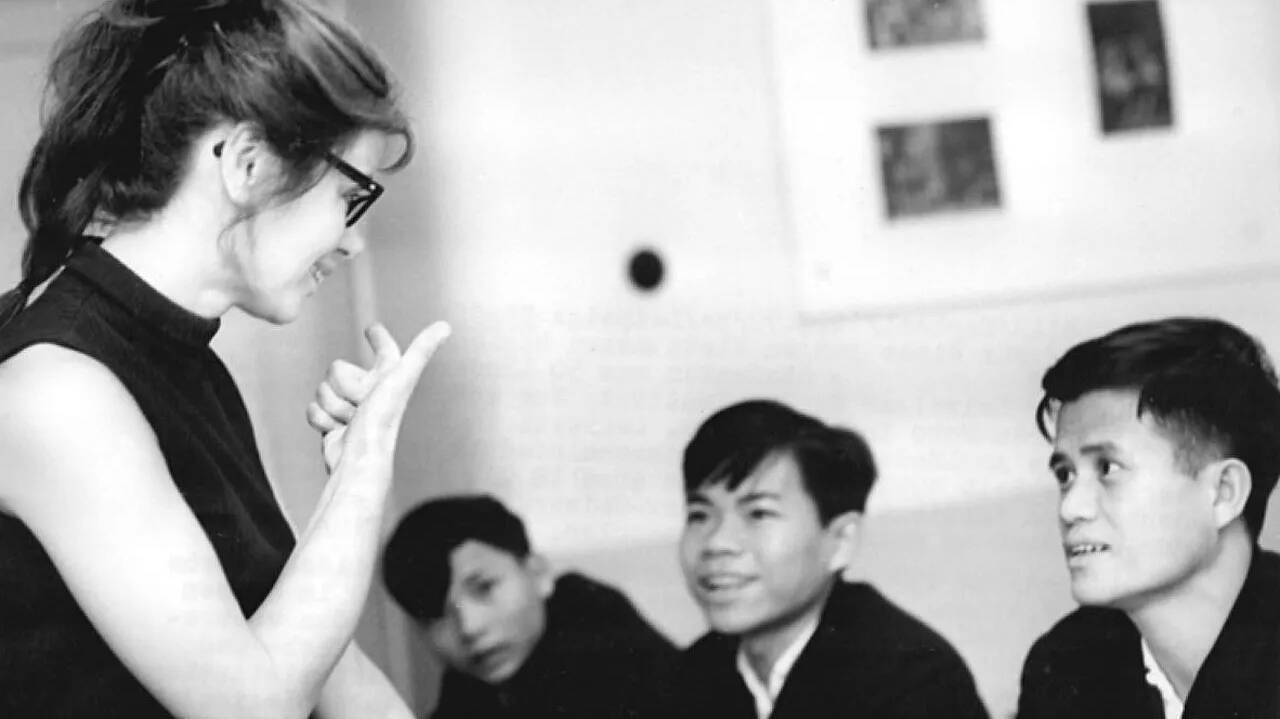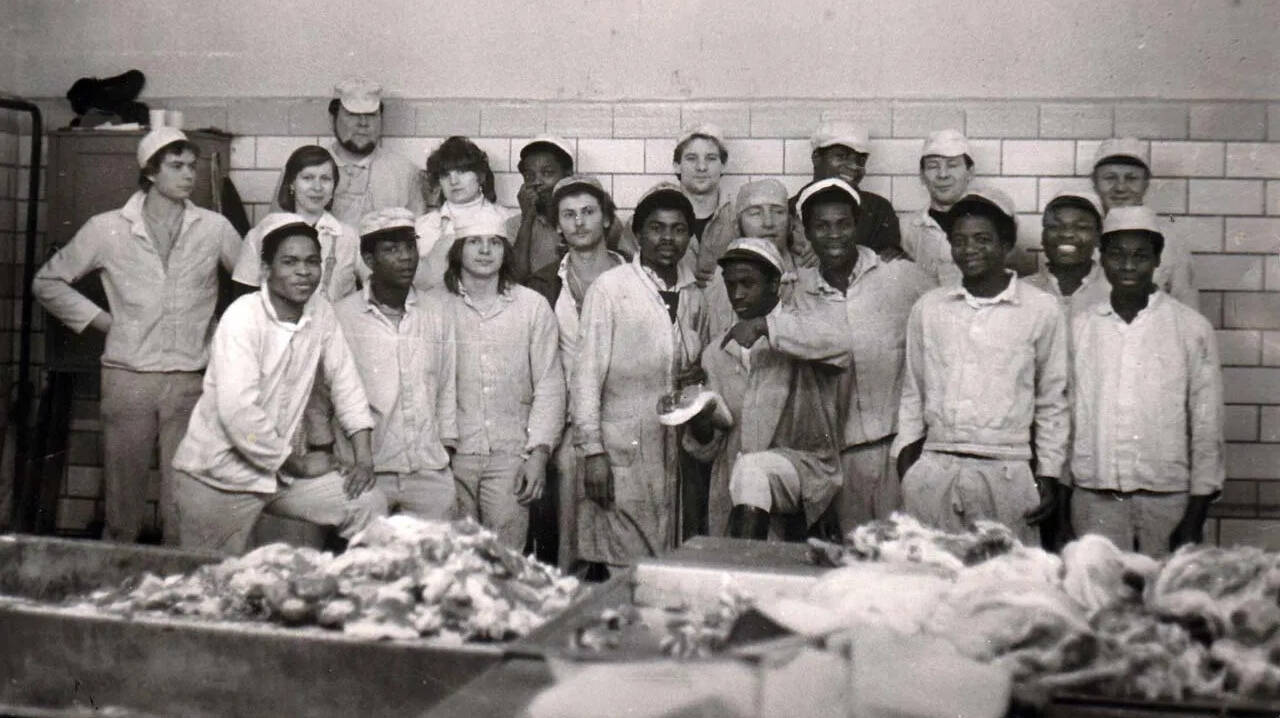
The German Democratic Republic (GDR) existed from 1949 to 1990, when its people voted by an overwhelming majority to dissolve the state and join their neighbours as newly minted citizens of the Federal Republic of Germany. Colloquially known as East Germany, this self-declared “workers’ and peasants’ state” arose from the ashes of World War II under Soviet tutelage and understood itself as a socialist state in the tradition of what was known in official parlance as “proletarian internationalism”. Never again, the state’s official propaganda claimed, would the German people invade and conquer their neighbours in a quest for national glory. Instead, the citizens of East Germany worked towards peace, understanding, and mutual development across Europe and the world. In foreign policy terms, this meant alliances with the other countries of the Warsaw Pact and fraternal nations in Asia and Africa, such as the Socialist Republic of Vietnam or the People’s Republic of Mozambique.
Isabel Enzenbach is a historian and fellow at the Center for Research on Antisemitism at the TU Berlin. Currently, her primary focus is on the personal photography of migrants in the GDR.
Julia Oelkers is a journalist and documentary filmmaker. Her work focuses on the issues of right-wing violence, racism, and migration
Over three decades after its collapse, the GDR’s legacy today is less associated with the lofty ideals it once espoused, so much as with the harsh restrictions it imposed on its citizens, symbolized most dramatically by the Berlin Wall that divided Germany’s historical capital from 1961 to 1989. The so-called “Anti-Fascist Protection Wall” had in reality been a response to the outflow of millions of workers to the West in the previous decade, which caused major problems for the East German economy and exacerbated an already tense situation on the country’s tight labour market. Forcing the workers to remain within the workers’ state may not have been ideal, the GDR’s rulers reasoned, but it was the only way to keep the economy from coming apart at the seams.
Ongoing labour shortages were also behind one of the lesser-known migration movements in East Germany: not that of Germans seeking to move West, but the tens of thousands of contract labourers who came to the GDR to work and live in the 1970s and 1980s. Hailing from Vietnam, Cuba, and other “socialist brother countries”, these workers moved to East Germany with their own ideas about why they were coming and how they would live. This particular aspect of life in divided Germany was recently the subject of an online documentary project, Minds of Their Own: Migrants in the GDR, hosted by the Center for Research on Antisemitism at the Technical University of Berlin with funding from the Rosa Luxemburg Foundation. Loren Balhorn spoke with the documentary’s creators, Isabel Enzenbach and Julia Oelkers, to learn more about the project and the thousands of people who came to the first socialist state on German territory to live, work, and pursue their dreams.
LB: When people hear the words “migration” and “East Germany”, most probably think of movement from the other direction—i.e., people who left the GDR for the West, not those who wanted to migrate into it. Where did you get the idea for Mind of Their Own? Do either of you have a personal or biographical connection to the issue?
IE: A “biographical connection” would be a bit of an exaggeration. I was involved in political work with migrants who came to Berlin after the pogrom in Hoyerswerda in the early 1990s, so I already knew about labour migration to the GDR from the Global South, but that was limited to contract work. Later, I met a woman from Mongolia who came to the GDR for an apprenticeship as a 16-year-old. Her story seemed unknown to me and worth telling. Personal encounters and my own personal interest as a historian came together in my case.
JO: The first documentary film I was involved in as a student told the story of a Mozambican contract worker named Manuel Nhacutou, who experienced the racist attacks in Hoyerswerda in 1991. Since then, I have dealt with the issues of racism and migration, including in the GDR, in various films and documentary projects.
Has a lot of research already been done on this episode of modern history?
IE: Yes, there is a lot of research and a lot of exciting academic work. What’s novel about the online documentary is that we worked with video interviews with migrants from different countries—students, contract workers, and political emigrants all have their say. We combined their subjective experiences with introductory texts, historical documents, illustrations, and animations. Academic research is usually much more specific and focused on individual topics or countries of origin. That said, we drew on that work quite heavily.
When did foreigners start coming to the GDR? Where did most of them come from?
IE: As unbelievable as it may sound, the first foreign student came to Leipzig to study medicine as early as 1946. Unfortunately, it’s no longer possible to determine from which country. In 1951, eleven Nigerian students were able to enrol at the university in Leipzig. They had come to Berlin for the World Youth and Student Festival and couldn’t return to Nigeria afterwards. Between 1951 and 1989, a total of about 70,000 students from 125 different countries studied in the GDR.
The situation was different for labour migrants. Originally, the GDR sought to distinguish itself from West Germany and not compensate for its own labour shortage by employing “guest workers”. This kind of arrangement was criticized as typical capitalist exploitation, and there was to be no such thing in the GDR. That’s why the people who we call “contract workers” today were not called that in GDR terminology. They were called “Mozambican, Vietnamese, etc. Werktätige”, which basically means labourers or workers. This was to emphasize their equality with East German workers.
The bilateral agreements with the various countries therefore always emphasized the training and education aspect for the workers involved. The first agreement was with Poland in 1963. With the ever-increasing demand for labour, an agreement with Hungary followed in 1967. The first agreement with a non-European country, namely with Algeria, was reached in 1974, and in 1975 with Cuba. The agreements with Mozambique in 1979 and Vietnam in 1980, and later also with Angola, Mongolia, and China, were intended to compensate for the dramatic labour shortage that emerged in the 1980s. Most migrants came from Vietnam and Mozambique in the second half of the 1980s. Their living and working conditions were generally worse than those who had come earlier.
What kind of jobs did they perform? And on what grounds were they sent from their home countries? After all, the socialist bloc was not exactly known for granting its citizens freedom of movement.
JO: The areas of employment were very different, and were also oriented towards the labour needs of the GDR. Contract workers were employed in the port of Rostock, in meat processing plants, in the textile industry, in opencast lignite mining, in agricultural enterprises, engine factories, or on the railroad. In some cases, there were also specific large-scale projects in the countries of origin, such as coal mining in Moatize in Mozambique. The workers trained in Lusatia, East Germany and the machines and technology from the GDR were later to be deployed back home.
Travelling to the GDR did not usually mean freedom of movement for the workers. The Mozambicans and Vietnamese had their passports confiscated on entry and replaced by a temporary GDR identity card. Crossing the border was therefore not possible.
Most of those who came to the GDR to work or study were from socialist countries. Were they usually dyed-in-the-wool Communists? What was their relationship to the ruling parties in their home countries and in the GDR?
IE: What exactly constitutes a “dyed-in-the-wool” Communist is a question of definition—and thus very difficult to answer. The vast majority of people who came to the GDR were young, between 17 and 25 years old. Often they did not make the decision themselves, but their parents did.
A number of motivations played a role for the people we interviewed for the documentary: in the case of Nguyen Do Thinh, his mother did everything in her power to prevent her son from becoming “cannon fodder” as a South Vietnamese in the Vietnam War. Pham Thi Hoài had very, very good grades, so she received a place at university in the GDR at the age of 16. She was the daughter of very dedicated Communists and was one herself as well. The family’s belief that this would get their daughter a place at university brought Orquídea Chongo to the GDR as a Mozambican contract worker. Kadriye Karcı found refuge in the GDR as a dedicated Communist from Turkey, but her conviction dwindled there over time.
I think more important than the relationship to the parties was the hope for a better life, a good education, or protection from persecution.
One of the most interesting parts of the documentary dealas with resistance and strikes among migrant workers in the GDR. How frequent were these work stoppages and what forms did they take? How did the state react to them? Did they pose an ideological dilemma for the GDR?
JO: There were always refusals to work and smaller strikes, mainly to challenge discrepancies and the lack of transparency in the payroll or to improve working conditions. In the case of strikes, the respective embassies were informed immediately and the Stasi observed them closely. Political cadres from the countries of origin, together with the factories, worked quickly to ensure that work was resumed. Often, the “ringleaders” and “troublemakers” identified by the Stasi were expelled a short time later. Even if the strikes pointed to an ideological dilemma, they were rigorously persecuted.
Given these conditions, the many forms of resistance by migrant workers in the GDR are difficult to quantify. In Minds of Their Own, we documented one case in detail using the example of a strike by Vietnamese apprentices and depicted it with the aid of illustrations and animations.
A particularly noteworthy group were the thousands of left-wing Chileans who found refuge in the GDR after the 1973 coup. How did the Chileans find life in the GDR—was it what they imagined socialism would be like?
IE: In Minds of Their Own, Carlos Medina tells a beautiful story about how, after arriving in the GDR, people would raise their fists in the air and shout “Venceremos!” when they crossed paths with him. The Chileans encountered a great deal of sympathy, but also political distrust.
After a friendly reception, it quickly became clear that most of the Chileans were to be sent to work in production. Many did not imagine their life in the GDR would be like this, and migrated elsewhere or returned to Chile at the first opportunity. Medina managed to study theatre in Berlin and eventually direct at the Berliner Ensemble himself. His dream came true in that sense. But not everyone had such assertiveness and luck.
What happened to the GDR migrants after the fall of the Wall? Were they able to stay, and did they manage to integrate into reunified German society?
JO: For the migrants, the end of the GDR also meant the end of the contractual basis for their residence status. Students’ scholarships were discontinued, while contract workers lost their jobs and with them their spots in the company-owned hostels. Hardly any information was available on how things would continue for them. The intergovernmental agreements were changed and contract workers who left before the end of their contracts received 3,000 Deutschmarks as compensation. In this situation, the majority left the country.
For those who remained, a long struggle for the right to stay began. It was not until 1997 that they were granted permanent residency and work permits.
The GDR has been gone for over 30 years, and many of the places depicted in your documentary are hardly recognizable today. Why is it still important to document the stories of the GDR migrants? What do they tell us?
IE: I don’t think we need any extra justification as to why the story of the GDR migrants is worth telling. It’s part of history, and knowing your own history helps in life and in society. It’s also important for the second generation to be able to recognize their parents’ stories in Germany’s cultural memory.
What do they tell us? Very different things. Perhaps there is one—unspoken—common message: “Listen to us!”
www.bruderland.de/en
Directed by Isalbel and Enzelbach and Julia Oelkers
A project by the Center for Research on Antisemitism (Technische Universität Berlin) and out of focus medienprojekte. Supported by the Federal Foundation for the Study of the Communist Dictatorship in Eastern Germany and the Rosa Luxemburg Foundation.

